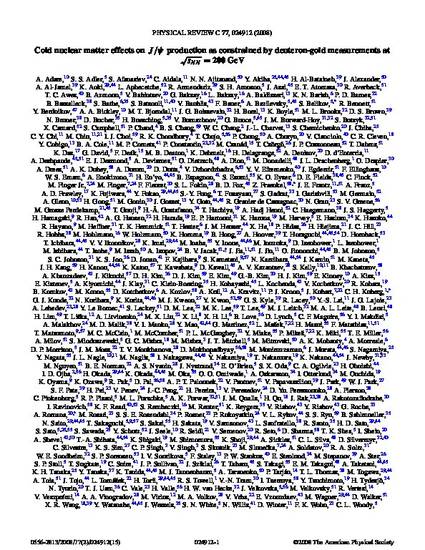
Article
Cold nuclear matter effects on J/psi production as constrained by deuteron-gold measurements at root S-NN=200 GeV
Physical Review C
Document Type
Article
Publication Version
Published Version
Publication Date
2-1-2008
DOI
10.1103/PhysRevC.77.024912
Abstract
We present a new analysis of J/psi production yields in deuteron-gold collisions at root s(NN) =200 GeV using data taken from the PHENIX experiment in 2003 and previously published in S. S. Adler [Phys. Rev. Lett 96, 012304 (2006)]. The high statistics proton-proton J/psi data taken in 2005 are used to improve the baseline measurement and thus construct updated cold nuclear matter modification factors (R-dAu). A suppression of J/psi in cold nuclear matter is observed as one goes forward in rapidity (in the deuteron-going direction), corresponding to a region more sensitive to initial-state low-x gluons in the gold nucleus. The measured nuclear modification factors are compared to theoretical calculations of nuclear shadowing to which a J/psi (or precursor) breakup cross section is added. Breakup cross sections of sigma(breakup)=2.8(-1.4)(+1.7) (2.2(-1.5)(+1.6)) mb are obtained by fitting these calculations to the data using two different models of nuclear shadowing. These breakup cross-section values are consistent within large uncertainties with the 4.2 +/- 0.5 mb determined at lower collision energies. Projecting this range of cold nuclear matter effects to copper-copper and gold-gold collisions reveals that the current constraints are not sufficient to firmly quantify the additional hot nuclear matter effect.
Copyright Owner
American Physical Society
Copyright Date
2008
Language
en
File Format
application/pdf
Citation Information
Andrew Adare, Paul Constantin, Nathan C. Grau, John C. Hill, et al.. "Cold nuclear matter effects on J/psi production as constrained by deuteron-gold measurements at root S-NN=200 GeV" Physical Review C Vol. 77 Iss. 2 (2008) p. 024912 Available at: http://works.bepress.com/craig-ogilvie/237/

This article is published as Adare, A., Steven S. Adler, S. Afanasiev, C. Aidala, N. N. Ajitanand, Y. Akiba, H. Al-Bataineh et al. "Cold nuclear matter effects on J/ψ production as constrained by deuteron-gold measurements at s NN= 200 GeV." Physical Review C 77, no. 2 (2008): 024912. DOI:10.1103/PhysRevC.77.024912. Posted with permission.